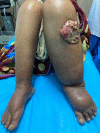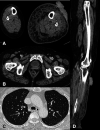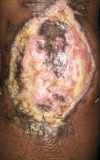Chronic lymphoedema: a nidus for squamous cell carcinoma
- PMID: 35537771
- PMCID: PMC9092127
- DOI: 10.1136/bcr-2021-248543
Chronic lymphoedema: a nidus for squamous cell carcinoma
Abstract
Lymphoedema is a chronic debilitating condition characterised by diffuse swelling caused by lymphatic obstruction. The secondary form of lymphoedema is more common than the primary form. Untreated filariasis remains an important cause of lymphoedema in developing countries. The most common complication of chronic lymphoedema is cellulitis. It is also a risk factor for the development of neoplasms such as lymphangiosarcoma, squamous cell carcinoma, melanoma, lymphoma and malignant fibrous histiocytoma. We report a case of a woman in her 60s who developed squamous cell carcinoma in the background of chronic lymphoedema.
Keywords: Dermatological; Skin cancer.
© BMJ Publishing Group Limited 2022. No commercial re-use. See rights and permissions. Published by BMJ.
Conflict of interest statement
Competing interests: None declared.
Figures



Similar articles
-
Squamous cell carcinoma arising in chronic lymphoedema.Br J Dermatol. 1997 Mar;136(3):384-7. Br J Dermatol. 1997. PMID: 9115922 Review.
-
Melanoma arising in chronic ulceration associated with lymphoedema.J Wound Care. 2013 Feb;22(2):74-5. doi: 10.12968/jowc.2013.22.2.74. J Wound Care. 2013. PMID: 23665661
-
Squamous cell carcinoma of the penis in a patient with chronic isolated penile lymphoedema.Urol Int. 2006;76(1):87-8. doi: 10.1159/000089742. Urol Int. 2006. PMID: 16401928
-
Lymphangiosarcomata--experience in a lymphoedema clinic.Palliat Med. 1995 Jan;9(1):55-9. doi: 10.1177/026921639500900108. Palliat Med. 1995. PMID: 7719518 Review.
-
Factors associated with cellulitis in lymphoedema of the arm - an international cross-sectional study (LIMPRINT).BMC Infect Dis. 2024 Jan 18;24(1):102. doi: 10.1186/s12879-023-08839-z. BMC Infect Dis. 2024. PMID: 38238718 Free PMC article.
Cited by
-
Postamputation diagnosis of squamous cell carcinoma in a patient with lymphedema.J Vasc Surg Cases Innov Tech. 2023 Jan 14;9(1):101100. doi: 10.1016/j.jvscit.2023.101100. eCollection 2023 Mar. J Vasc Surg Cases Innov Tech. 2023. PMID: 36852314 Free PMC article.
References
-
- Depairon M, Lessert C, Tomson D, et al. . [Primary lymphedema]. Rev Med Suisse 2017;13:2124–8. - PubMed
Publication types
MeSH terms
LinkOut - more resources
Full Text Sources
Medical
